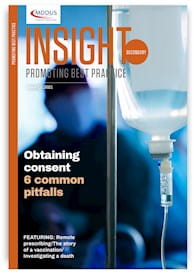
MORE than 40,000 contacts were made to the National Domestic Abuse Helpline during the first three months of lockdown, mostly by women seeking help. The charity Refuge, which runs the national helpline, said in June that calls and contacts were nearly 80 per cent higher than usual.
Household isolation measures during the pandemic have increased risks for those experiencing or feeling under threat from domestic abuse. There are also reduced opportunities for health and social care professionals to recognise and act on cases. The traditional sanctuary provided by a private face-to-face medical consultation is no longer generally available, with many clinical interactions in primary care now being undertaken remotely, and an increasing number of hospital consultations following suit. Holding consultations via telephone or video feed makes it difficult to be certain that conversations are not being listened to, monitored or even recorded by a perpetrator.
Domestic abuse is not just about physical violence, where evidence may be obvious to the clinician on a video feed, such as visible bite marks, bruises or burns. It also includes:
- exercising forms of coercive control
- the use of threats and intimidation
- economic abuse where finances are being controlled or withdrawn
- sexual coercion and violence
- emotional abuse through belittling and being made to feel worthless.
The General Medical Council (GMC) provides clear advice on the protection of vulnerable patients in its Adult Safeguarding ethical guidance. It states: "Take prompt action if you think that patient safety, dignity or comfort is or may be seriously compromised, and to offer help if you think their rights have been abused or denied."
There is also a helpful GMC case study regarding suspected domestic abuse.
NICE provides guidance in its Domestic Violence and Abuse Quality Standard 2016, which advises: "Some people who present to frontline health and social care practitioners have indicators of possible domestic violence or abuse. Services should ensure that they can provide a safe and private environment in which people feel able to disclose that they are experiencing domestic violence and abuse."
Therein lies the conundrum. The advent of remote consulting policies and arrangements during the Covid-19 pandemic takes clinical encounters away from private face-to-face, neutral and safe environments and into the patient’s home domain, the very place where they are likely to be experiencing any domestic abuse issues. By their very nature, Covid-19-related household restrictions may also lead to patients being more isolated from family and friends and the other support networks normally relied upon. To cap it all, an abuser is likely to be aware of the risks to them during a remote consultation with a health professional.
PRACTICAL STEPS
It is important to be aware that a perpetrator of domestic abuse may be monitoring their victim during a remote consultation or in subsequent communications. This will certainly involve listening to what your patient is saying, but potentially what you are saying at the other end of the phone or video feed. Very little may escape their notice, which can be extremely difficult to manage with access by remote means only.
There are some practical steps you can consider. Check first that the patient is alone and able to talk freely without being overheard. If it is apparent that someone else is present, you could remind the patient that you are going to be asking about potentially sensitive issues and that ideally the conversation should be private. This might involve asking directly whether it would be more convenient for them to move to another room.
Secondly, consider if the patient seems more withdrawn or reticent than in previous encounters. Could this be an indicator that they are under duress? A gut feeling or hunch about a patient’s reactions or demeanour may prove to be accurate.
Should you suspect that a patient may be in immediate danger or risk of harm then ask directly. Given a ‘yes’, the obvious advice is for them to call 999 or for you to be prepared to do so yourself. Asking ‘closed questions’ during the consultation which illicit yes or no responses can be helpful if you suspect that the patient isn’t able to talk freely. This can help gather important intelligence quickly while taking into account that the perpetrator may be listening to the victim’s responses.
Such an approach is not ideal when carrying out a full consultation but it may allow you to make an appropriate initial assessment and response.
Some documented tell-tale signs in a remote consultation that may indicate an abusive situation include:
- a ready if not entirely plausible excuse for visible injury
- a patient checking responses with a partner present in the room – or appearing overly worried about pleasing them
- changes in personality – a patient previously confident now displaying low self-esteem
- wearing clothes that don’t seem to fit the season (such as long sleeves in summer) to conceal injuries.
Other practical measures to consider if an abusive situation is suspected include:
- arranging a call back at a later safe time
- being willing to spend more time listening
- being flexible in communication methods and opportunities
- doing what you would normally do in a face-to-face consultation: a basic risk assessment, enquiring about children, recording concerns and seeking advice from colleagues.
Consider signposting/referring the patient onwards to other services and accurately record any grounds you have to suspect that abuse may be taking place. Ensure that your observations are objective and factual, avoiding supposition and conjecture.
You should also raise awareness about this issue with your admin and reception teams. A patient who seems upset or anxious when offered a remote appointment might in some cases suggest that they are anxious, frightened and under duress – and the matter should be escalated for further clinical consideration.
Finally, if your gut feeling is that something is amiss, it’s better to be safe and arrange for a prompt face-to-face appointment. Refusal to agree to this by the patient may not be indicative of an abusive situation but it could provide additional evidence to support further intervention.
Members are also reminded that (at the time of writing this article) the prevailing Covid-19-related isolation rules do not apply if a person has to flee domestic violence in the home. Providing written guidance about this to patients (for example on your website or social media groups) could be helpful in both educating and reassuring at-risk patients.
ACTION POINTS
- Review whether your current remote consulting arrangements provide a safe and private environment for patients to raise domestic abuse issues.
- Follow professional guidelines as far as practical when offering remote consultation appointments.
- Remain alert to the potential for abusers to be monitoring or recording remote consultations.
- Remain vigilant in remote consultations to para-verbal communication and other indicators that abuse may be taking place.
OTHER RESOURCES
- GOV.UK: Domestic abuse: Get help during the coronavirus (COVID-19) outbreak.
- Refuge and National Domestic Abuse Helpline.
- Safe Lives: Guidance for NHS volunteers: Domestic abuse and COVID-19. Download the PDF.
- Scottish Government/COSLA: Coronavirus (COVID-19) Supplementary National Violence Against Woman Guidance. Download the PDF.
- Standing Together against domestic abuse.
- UK SAYS NO MORE: Safe Spaces.
- Women's Aid: Covid-19 Resource Hub.
This page was correct at the time of publication. Any guidance is intended as general guidance for members only. If you are a member and need specific advice relating to your own circumstances, please contact one of our advisers.
Read more from this issue of Insight Secondary

Save this article
Save this article to a list of favourite articles which members can access in their account.
Save to library
